Manual Removal
Hand-Pulling
 |
Weeds in the water, a massive effort.
Hand-pulling requires digging out plants and their roots, or lifting or netting floating plants from the water surface. Plant material is then deposited away from the shoreline. Hand-pulling is practical for controlling small amounts of aquatic plants in easily accessible, shallow water. Otherwise the process may require the assistance of trained SCUBA divers. The effectiveness of hand-pulling depends on sediment type, water visibility and thoroughness of removal. A high degree of control, lasting more than one season, is possible depending upon the species of plant and if complete removal can be achieved. In many cases, hand pulling small amounts of plants from residential shorelines does not require a permit.
|
Diver-Assisted Dredging
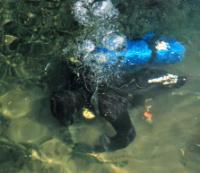 |
Divers suction dredging hydrilla from Wakulla Springs (J. Schardt, 2002 FL DEP).
A variation of hand-pulling is diver-assisted dredging. Divers working in deep water hand-pull plants and feed them into a flexible four-inch hose. The hose is connected to a vacuum pump on a barge, boat or dock, which draws up both water and plant material. Plants are screened and deposited on an upland site away from the water body. Diver-assisted dredging has been used only in the fast moving waters of the Wakulla River to remove hydrilla from small high-use areas where mechanical harvesting or herbicide applications were not practical.
|
Barriers
Fences, Booms, and Cables
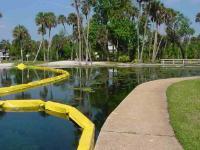 |
Floating, curtain-style containment booms
Fences, booms, and cables have been employed for decades in Florida public waters to keep floating plant masses out of particular areas. Historically, fences were erected along sections of the St. Johns River to prevent water hyacinths from blocking the navigation channel, and booms were stretched across canals to keep water hyacinths from spilling into (or out of) adjacent lakes.
More recently, pilings and cables have been installed at the outfalls of lakes or in front of flood control structures to keep floating rafts of plants (also called tussocks or floating islands) from clogging these water conveyances. State or federal permits may be required prior to installing any device in public or navigable waters.
|
Benthic
Benthic barriers consist of materials such as sand and gravel, burlap, plastic, fiberglass screens, nylon, and other synthetic substances that cover rooted plants and prevent them from growing. Benthic barriers typically kill the covered plants in one to two months and prevent new plants from growing. Benthic barriers are labor intensive to install and maintain and are therefore generally restricted to small locations such as ornamental ponds, swimming areas, and around boat docks. Benthic barriers are not selective; they control all plants and other living organisms that are covered. Plants will eventually regrow if sediments accumulate on top of the material.
Silt Curtains
Other types of barriers such as silt curtains can assist in aquatic plant control efforts. Silt curtains are suspended vertically from the water surface to the sediment. They are used to augment herbicide treatments by prolonging herbicide contact with plants behind the curtains in isolated coves or along shores of large open systems where wave action can quickly dissipate herbicides. They also are used to deflect water currents away from herbicide treated areas in slow flowing rivers, streams, or spring runs to minimize dilution. As with benthic barriers, silt barriers are expensive to install and maintain, so their application is limited to small areas where other options are less practical. State or local permits may be required to install benthic barriers.
Cutting / Shearing
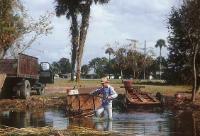 |
Cut the weeds, then rake them in
Cutting or shearing requires the use of a variety of tools. Machetes simply chop plants. Tethered rakes or blades are thrown into the water and retrieved by hand. Heavy metal weights, chains and even bed springs can be towed through weed beds to cut or pull plants from the bottom. Hand-cutting can minimize environmental disruption if done with care, but rapid regrowth is possible if the roots are not removed. Cutting is time-consuming, labor-intensive, and the effects generally last less than one growing season.
Tossing a tethered blade into the water to shear plants and then raking debris from the water can be cost-effective for clearing small shoreline areas. Dragging heavy weights along the bottom is not practical for lakes and rivers, but is an option for controlling aquatic plants in ditches and canals.
|
Water Level Manipulation
Prior to urbanization and flood control efforts, Florida’s shallow lakes underwent periodic drying and flooding. Nowadays, water levels in most of Florida’s “natural” lakes are regulated for flood control, crop irrigation or drinking water by structures such as dams, weirs, and gates, or conveyances such as outfall ditches and canals to other waters. These water level manipulations provide for year-round recreational and other water uses, but also allow dense plant growth and muck accumulation if the waters never dry up or flood. Managers seek to mimic nature through a variety of water level manipulation techniques.
Drawdown
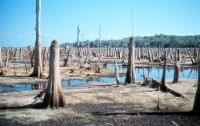 |
Drawdown exposing hydrilla on Rodman Reservoir (J. Schardt, 2002, FL DEP)
Drawdown, also called drydown or dewatering, refers to the lowering of water levels. It has been used for centuries to expose to air (oxidize) and dry excess sediment or muck, alter fish populations, and control aquatic weeds. This technique requires a dam or other structure to lower water levels. The process may be restricted by public needs for water, water rights, or the lack of a predictable source of water for refilling. In Florida, drawdowns are most effective for controlling floating, emergent, and submersed plant species in the winter to take advantage of drier weather, freezes, and prescribed fire to further suppress target plants
|
Fluctuating Water Levels
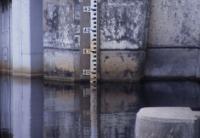 |
Manipulating water level, a way to manage herbicide treatments
Because it is nearly impossible to completely drain most Florida lakes, resource managers also seek to alter water levels to augment aquatic plant control efforts. Lowering water levels by several inches to several feet increases water holding capacity so that unanticipated rainfall does not flush herbicide-treated waters from the system. It also reduces the lake volume, thereby reducing the amount of herbicides needed. This translates to lower management costs. For example: A six-foot reduction in water level on 19,000-acre Lake Toho (Osceola County) greatly reduced herbicide amounts used for hydrilla control and saved approximately six million dollars in one year.
|
Flooding
After an herbicide application to control submersed invasive species like hydrilla, managers sometimes work to increase water levels by several feet to reduce light penetration through the water. This further stresses target plants and extends the duration of control. Flooding, an extreme example of water level fluctuation, can be used in lakes to strand invasive floating plants like water lettuce. Flooding can be used especially when favorable wind conditions push target plants to secluded shorelines. Water levels are then quickly reduced to leave stranded plants in dry upland areas where they do not survive. This strategy is used approximately every three years on Rodman Reservoir (Putnam/Marion Counties).
Other water level manipulations include reflooding dried marshes in Lake Okeechobee to suppress the regrowth of torpedograss controlled with herbicides or prescribed fire; and increasing water levels to approximately four feet for extended periods to reduce dense stands of cattail.
Prescribed Fire
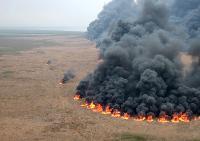 |
Fire, another management tool, to control dense torpedograss thatch on Lake Okeechobee
Fire is a natural process that commonly occurs when Florida’s shallow lakes and marshes dry out. For centuries, periodic burning sparked by lightning or extremely dry weather has controlled dense plant growth in Florida lakes and marshes. Managers use prescribed or planned fire to intentionally burn the thick build-up of plants and organic debris called thatch.
Thatch can accumulate quickly in stabilized water bodies when they dry out. Fire also stimulates new growth of some invasive plants such as torpedograss, making them more susceptible to herbicide treatments. Prescribed fire requires careful planning, permits and consideration of the impacts to air quality, human health and safety, protection of structures, and motorist visibility.
|
Sediment Removal
Scraping
In some cases during extreme droughts or prescribed drydowns, accumulated vegetation and sediment (muck) may be removed from a lake or reservoir. In Lake Jackson (Leon County), scraping machines and dump trucks removed years of accumulated sediment from the exposed lake bottom after a natural sink hole opened and drained much of the water. Another muck removal project took place on Lake Toho.
Dredging
In other cases, vegetation and sediments may be removed by dredging. In this case, water remains in the system and sediment is removed using floating dredging machines and pumps (see Lake Trafford (Collier County)). In other cases, floating masses of aquatic vegetation and sediments are shredded to facilitate dredging (see Lake Panasoffkee (Sumter County)).
Sediment removal is expensive and causes significant environmental impacts. Therefore, a considerable amount of planning and permitting is involved to identify priority control areas, minimize impacts to water quality and locate suitable disposal sites. Most sediment removal projects are conducted to alleviate problems associated with the accumulation of organic material, and aquatic plant control is a side benefit rather than a management goal. No matter how thorough, sediment removal leaves seeds and other reproductive material behind and aquatic plants usually regrow fairly quickly in Florida’s shallow waters.
Light Attenuation (Dyes)
Light attenuation or reduction limits plant growth by reducing light penetration into the water and inhibiting photosynthesis. Sunlight is obstructed by special non-toxic (usually blue) dyes. Light attenuation mimics the natural effects of tannins or turbidity in the water and is most effective for controlling submersed rooted plants or algae. The concentration of dyes must be sufficiently maintained in the water, so this method of control is limited to small, shallow ponds.
Nutrient Manipulation (Fertilization)
Plant growth can be affected if at least one essential nutrient is limited. Nitrogen and phosphorus are the most common nutrients influencing plant growth in Florida lakes. Nutrient manipulation involves the application of aluminum, iron salts or calcium compounds (lime) to remove phosphorus from the water and to inactivate phosphorus in the sediment. Most rooted plants take up nutrients from sediments, not water. Aluminum sulfate (alum) is most commonly used. Removing or inactivating phosphorus can effectively reduce algal blooms, but the growth of most rooted plants is limited by nitrogen and there are no compounds readily available that inactivate nitrogen. Nutrient manipulation is best suited for water quality improvement and algae control. However, reducing nutrients and algae in the water may encourage more growth of aquatic weeds due to improved water clarity and light penetration, allowing weeds to grow in deeper areas.
Aeration
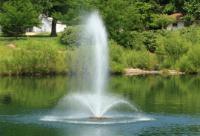 |
Fountain to aerate & circulate water in small systems
Aeration increases dissolved oxygen in the water, usually causing blue-green algae to be replaced by green algae. Water can be aerated using fountains at the water surface to increase circulation or by compressed air bubblers at the bottom that release oxygen into the water. Some researchers suggest that aerating water causes the deposit of iron oxide compounds on submersed plants which interferes with photosynthesis. Others suggest that aeration promotes the growth of filamentous algae that interferes with photosynthesis in submersed plants. Whatever the cause, aeration can be used for some degree of aquatic plant control in small systems.
|









